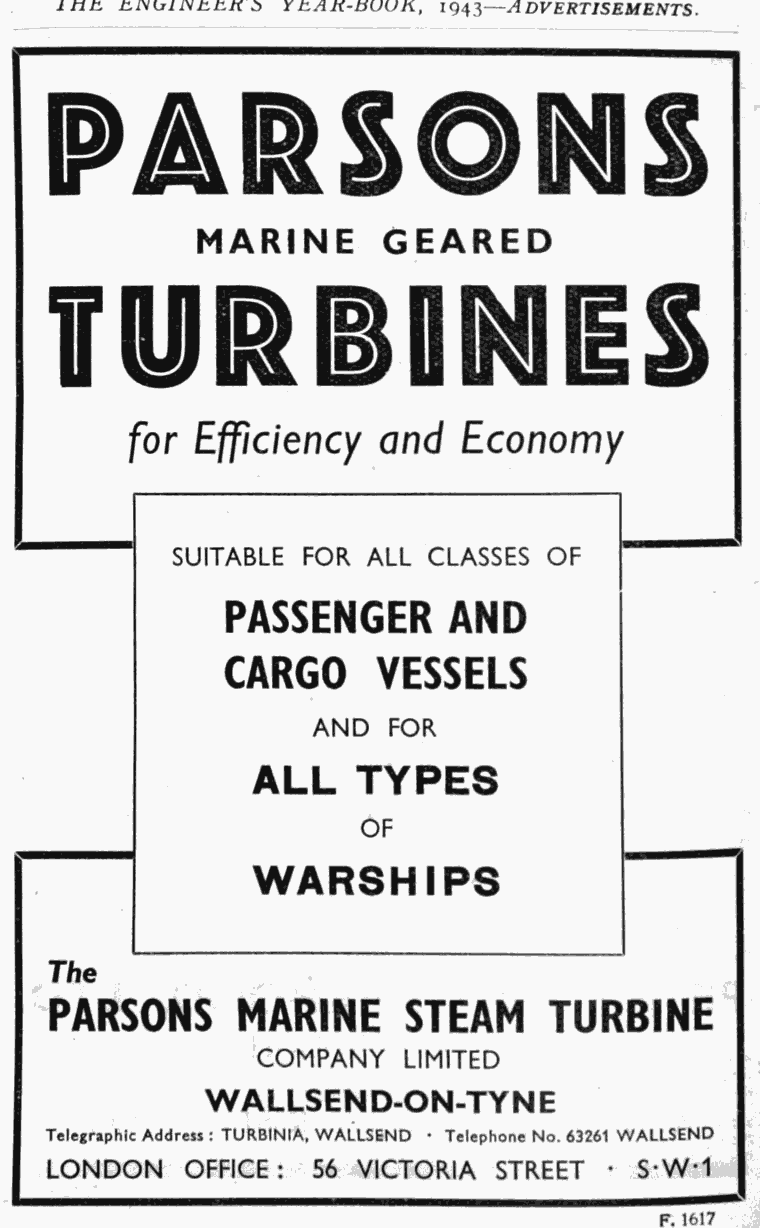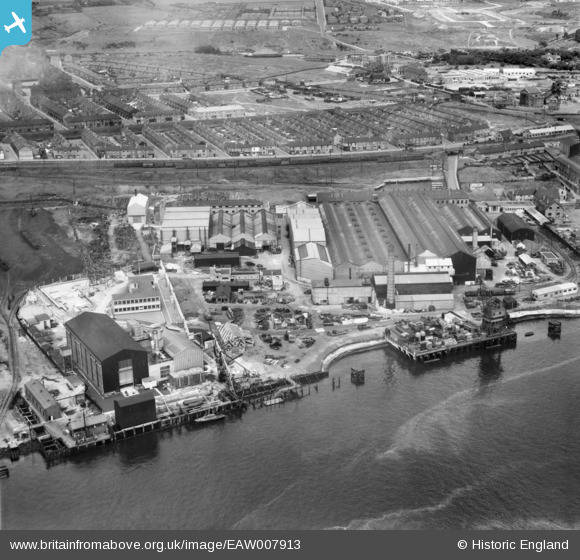EAW007913 ENGLAND (1947). The Parsons Marine Steam Turbine Company Works, Wallsend, 1947
© Copyright OpenStreetMap contributors and licensed by the OpenStreetMap Foundation. 2025. Cartography is licensed as CC BY-SA.
Nearby Images (15)
Details
| Title | [EAW007913] The Parsons Marine Steam Turbine Company Works, Wallsend, 1947 |
| Reference | EAW007913 |
| Date | 27-June-1947 |
| Link | |
| Place name | WALLSEND |
| Parish | |
| District | |
| Country | ENGLAND |
| Easting / Northing | 430701, 566071 |
| Longitude / Latitude | -1.5201532669924, 54.988209571246 |
| National Grid Reference | NZ307661 |
Pins

avocet |
Thursday 14th of March 2019 12:55:39 PM | |

Sparky |
Monday 2nd of October 2017 10:20:50 PM | |

avocet |
Wednesday 17th of December 2014 05:53:10 PM | |

avocet |
Wednesday 17th of December 2014 05:50:43 PM | |

avocet |
Wednesday 17th of December 2014 05:48:09 PM | |

avocet |
Wednesday 17th of December 2014 05:43:20 PM | |

avocet |
Sunday 23rd of March 2014 03:54:23 PM | |

avocet |
Sunday 23rd of March 2014 03:44:53 PM | |

avocet |
Sunday 23rd of March 2014 03:41:46 PM | |

avocet |
Sunday 23rd of March 2014 03:38:27 PM | |

avocet |
Monday 17th of March 2014 04:27:01 PM | |

avocet |
Monday 17th of March 2014 04:24:52 PM | |

avocet |
Monday 17th of March 2014 04:08:00 PM | |

avocet |
Monday 17th of March 2014 04:02:01 PM | |

totoro |
Saturday 8th of March 2014 05:39:50 PM | |

totoro |
Saturday 8th of March 2014 05:29:26 PM | |

totoro |
Saturday 8th of March 2014 05:28:35 PM | |

totoro |
Saturday 8th of March 2014 05:27:56 PM | |

totoro |
Saturday 8th of March 2014 05:27:23 PM | |

totoro |
Saturday 8th of March 2014 05:26:56 PM | |

totoro |
Saturday 8th of March 2014 05:25:57 PM | |

totoro |
Saturday 8th of March 2014 05:21:44 PM | |

totoro |
Saturday 8th of March 2014 05:18:12 PM | |

totoro |
Saturday 8th of March 2014 05:16:59 PM |
User Comment Contributions

The Parsons Marine Steam Turbine Company Works, Wallsend, Sir Charles Algernon Parsons was an English engineer, most remembered for his invention of the steam turbine and contributions to marine engineering. Charles Parsons became an apprentice at the engineering firm of W H Armstrong in Newcastle, where he was permitted to develop a steam engine at his own cost. He then joined Kitson's in Yorkshire, working on torpedoes, followed by a position as head of the electrical equipment department with a ship engine manufacturer in Newcastle. It was there in 1884 that Parsons developed a turbine engine and electrical generator that were able to produce a good supply of electricity cheaply and which revolutionised naval transport and warfare. Previous steam engines had been very noisy. By 1889 350 of Parsons’s steam turbines had been supplied. Parsons had the idea of powering a ship by steam turbine, and in 1894 the ship Turbinia was successfully tested. Despite the success of the turbine engine, initial trials with one propeller were disappointing. After discovering the problem of cavitation and constructing the first cavitation tunnel, Parsons' research led to him fitting three axial-flow turbines to three shafts, each shaft in turn driving three propellers, giving a total of nine propellers. Parsons decided to demonstrate his invention at the Spithead Naval Review in 1897, weaving in-between and outstripping the other warships in the harbour after Queen Victoria had inspected them. Following this he set up the Parsons Marine Steam Turbine Company. Two years later, HMS Viper, a turbine-driven destroyer, was launched, followed by HMS Cobra; by 1904, 26 ships powered by steam turbines were in operation. By 1910 all the leading engineering and shipbuilding companies in the U.K. had taken licences to build Parsons turbines 1956 Acquired by Richardsons, Westgarth and Co The company was absorbed into C. A. Parsons and Company and survives in the Heaton area of Newcastle as part of Siemens, a German industrial conglomerate. ... Sources used: http://www.sciencemuseum.org.uk/onlinestuff/ people/charles%20algernon%20parsons.aspx http://en.wikipedia.org/wiki/Turbinia http://en.wikipedia.org/wiki/Parsons_Marine_Steam_Turbine_Company Link: [[Parsons Marine Steam Turbine Company]] http://www.gracesguide.co.uk/Parsons_Marine_Steam_Turbine_Co Advert image from Graces Guide is licensed under Gnu FDL v1.2, equivalent to CC-BY-SA Creative Commons - Attribution - Share Alike v3 licence. |

totoro |
Saturday 8th of March 2014 04:55:39 PM |


![[EAW007913] The Parsons Marine Steam Turbine Company Works, Wallsend, 1947](http://britainfromabove.org.uk/sites/all/libraries/aerofilms-images/public/100x100/EAW/007/EAW007913.jpg)
![[EAW007915] The Parsons Marine Steam Turbine Company Works, Wallsend, 1947](http://britainfromabove.org.uk/sites/all/libraries/aerofilms-images/public/100x100/EAW/007/EAW007915.jpg)
![[EAW007920] The Parsons Marine Steam Turbine Company Works, Wallsend, 1947](http://britainfromabove.org.uk/sites/all/libraries/aerofilms-images/public/100x100/EAW/007/EAW007920.jpg)
![[EAW007921] The Parsons Marine Steam Turbine Company Works, Wallsend, 1947](http://britainfromabove.org.uk/sites/all/libraries/aerofilms-images/public/100x100/EAW/007/EAW007921.jpg)
![[EAW007919] The Parsons Marine Steam Turbine Company Works, Wallsend, 1947](http://britainfromabove.org.uk/sites/all/libraries/aerofilms-images/public/100x100/EAW/007/EAW007919.jpg)
![[EAW007914] The Parsons Marine Steam Turbine Company Works alongside the River Tyne, Wallsend, 1947](http://britainfromabove.org.uk/sites/all/libraries/aerofilms-images/public/100x100/EAW/007/EAW007914.jpg)
![[EAW007918] The Parsons Marine Steam Turbine Company Works alongside the River Tyne, Wallsend, 1947](http://britainfromabove.org.uk/sites/all/libraries/aerofilms-images/public/100x100/EAW/007/EAW007918.jpg)
![[EAW007912] The Parsons Marine Steam Turbine Company Works, Wallsend, 1947](http://britainfromabove.org.uk/sites/all/libraries/aerofilms-images/public/100x100/EAW/007/EAW007912.jpg)
![[EAW007917] The Parsons Marine Steam Turbine Company Works alongside the River Tyne, Wallsend, 1947](http://britainfromabove.org.uk/sites/all/libraries/aerofilms-images/public/100x100/EAW/007/EAW007917.jpg)
![[EAW007916] The Parsons Marine Steam Turbine Company Works alongside the River Tyne, Wallsend, from the north-west, 1947](http://britainfromabove.org.uk/sites/all/libraries/aerofilms-images/public/100x100/EAW/007/EAW007916.jpg)
![[EPW048225] The industrial area alongside the River Tyne, Hebburn, 1935](http://britainfromabove.org.uk/sites/all/libraries/aerofilms-images/public/100x100/EPW/048/EPW048225.jpg)
![[EPW050750] Boats moored alongside the Palmers Hebburn Co Shipbuilding Yard, Hebburn, from the north-west, 1936. This image has been produced from a damaged negative.](http://britainfromabove.org.uk/sites/all/libraries/aerofilms-images/public/100x100/EPW/050/EPW050750.jpg)
![[EPW048788] Shipyards on the River Tyne, Hebburn, from the west, 1935](http://britainfromabove.org.uk/sites/all/libraries/aerofilms-images/public/100x100/EPW/048/EPW048788.jpg)
![[EPW048785] Shipyards on the River Tyne, Wallsend, from the west, 1935](http://britainfromabove.org.uk/sites/all/libraries/aerofilms-images/public/100x100/EPW/048/EPW048785.jpg)
![[EPW054564] Ship-building yards and other industry alongside the River Tyne, Wallsend, from the north-east, 1937](http://britainfromabove.org.uk/sites/all/libraries/aerofilms-images/public/100x100/EPW/054/EPW054564.jpg)